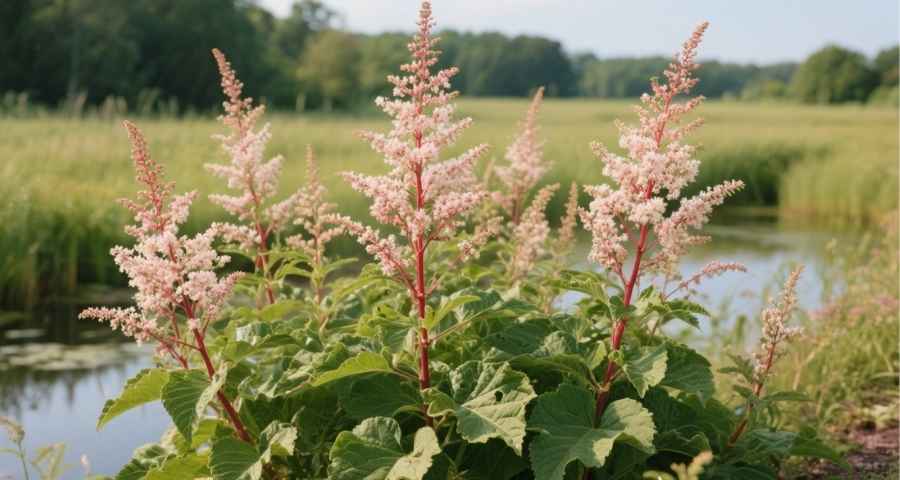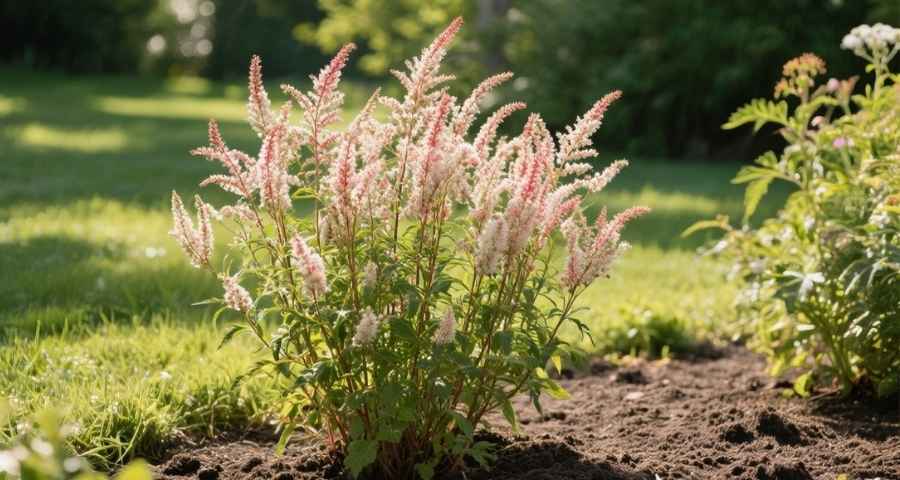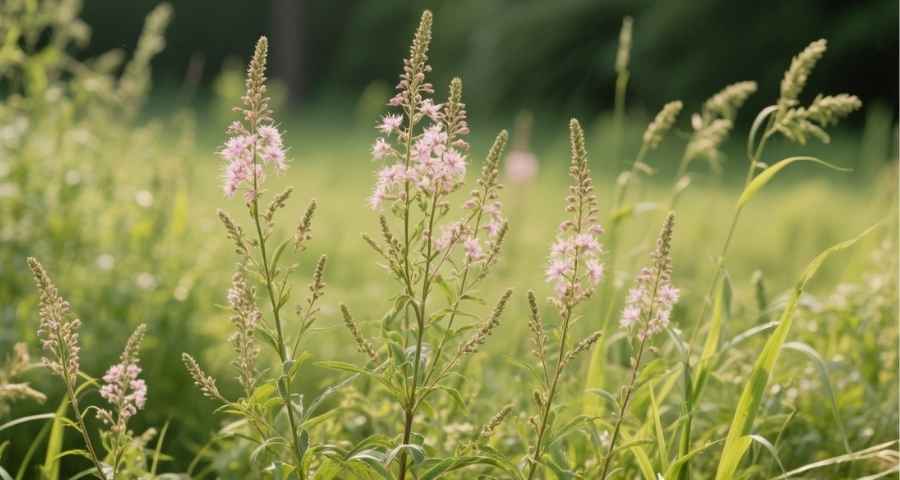Queen of the Prairie, or meadowsweet, is a tall and sturdy perennial that fills your garden with color after spring blooms fade. In midsummer, this North American native shows off clusters of pink or white flowers above its fern-like leaves. The flower stalks look soft but are tough enough to handle wind and less-than-ideal soil. This guide will help you grow this beautiful plant and bring a bit of wild charm to your garden.
You’ll find out how to pick the best spot, plant it the right way, and care for it all year. With blooms that last three weeks or more, Queen of the Prairie is an easy way to keep your garden colorful from mid to late summer.
What is Queen of the Prairie?

Queen of the Prairie (Filipendula rubra) is a perennial plant celebrated for its impressive height and beautiful blooms. Native to the wetlands and prairies of North America, it brings a touch of natural, meadow-like charm to any garden. The plant features large, deeply divided green leaves that create a lush base for the towering flower stalks.
Come midsummer, it sends up stems that can reach heights of 2 to 8 feet, topped with frothy, fragrant panicles of tiny pink or white flowers. These airy blooms attract birds and pollinators, making it a fantastic choice for wildlife-friendly gardens. It’s also deer-resistant, adding to its appeal for many gardeners.
How to Plant Queen of the Prairie
Planting Queen of the Prairie the right way helps it grow strong and healthy. Since it’s hard to grow from seed, it’s best to start with transplants from a local garden center. (Greayer, 2024)
When to Plant
Plant Queen of the Prairie in spring or early fall. This gives the roots time to settle in before facing summer heat or winter cold.
Where to Plant

Choosing the right spot is important for this plant to thrive.
- Sunlight: Plant it in a spot that receives full sun or part shade. It flowers most profusely in full sun but will appreciate some afternoon shade, especially in hotter climates. (Filipendula rubra ‘Venusta’, 2025)
- Soil: This perennial likes moist, well-drained soil rich in organic matter. Since it naturally grows in damp places, it’s perfect for rain gardens or spots in your yard that stay wet. (Queen of the Prairie (Filipendula rubra), n.d.)
- Placement: Because it grows tall, Queen of the Prairie is best planted at the back of a garden bed. Its leaves make a nice green background for shorter plants. It also works well as a living screen or natural fence along your property. (Filipendula rubra ‘Venusta’ – Romence Gardens & Greenhouses, 2025)
Planting Steps
- Dig the Hole: Prepare a hole that is roughly the same depth and width as the container in which the plant came.
- Amend the Soil: Add plenty of compost to the soil you took out of the hole. Queen of the Prairie grows best in rich, fertile soil.
- Prepare the Plant: Carefully take the plant out of its pot and gently loosen the roots at the bottom.
- Position and Backfill: Set the plant in the hole so the top of the root ball is even with the ground. Fill the hole with the improved soil and press it down gently to remove air pockets.
- Water Thoroughly: Water the new plant well to help it settle. If you’re planting more than one, space them about 2 feet apart for good air flow.
Queen of the Prairie Care Guide

After it’s established, Queen of the Prairie is easy to care for. It usually doesn’t need staking, but a few simple care tips will help it look great every year.
Water
Keeping the soil moist is important. Water your Queen of the Prairie often, especially when it’s dry, but don’t let the soil get soggy.
Fertilizer
This plant likes rich soil. Each spring, spread compost around the base to give it the nutrients it needs to grow and bloom well.
Pruning
You don’t need to prune much. If you’re okay with the plant spreading, you can leave the old flowers. The faded blooms look nice in fall and winter. For a tidy garden and to prevent disease, cut the flower stalks to the ground in late fall or early spring before new growth starts.
Pests and Problems
Queen of the Prairie is generally pest-free. Occasionally, it may be bothered by Japanese beetles or powdery mildew. (Filipendula rubra Queen of the Prairie, 2025) If the foliage becomes unsightly, you can cut it back in late summer; the plant will likely recover the following year. Ensuring good air circulation by spacing plants properly can help prevent powdery mildew. (Hudelson, 2024)
Propagating Queen of the Prairie

It’s best to leave this perennial alone, since dividing it can slow its growth for a few years. (Filipendula rubra (Queen-of-the-Prairie), 2024) But if you want more plants, you can divide them in spring.
- Division: Carefully dig up the plant, keeping a large amount of soil around the roots. Use a sharp spade or knife to divide the root ball, making sure each new section has at least one healthy root shoot. Replant the divisions at the same depth they were previously growing and water them generously.
- Self-Seeding: In moist, rich soil, Queen of the Prairie will spread by self-seeding and can form a big group over time. (Filipendula rubra – Queen of the Prairie, n.d.) To keep it from spreading too much, remove the flowers before they set seed. (Filipendula rubra – Queen of the Prairie – Native Plant, n.d.)
Companion Plants for Queen of the Prairie
For a beautiful, meadow-style garden, plant Queen of the Prairie with other North American natives that attract wildlife. Some good companion plants are:
- Joe Pye Weed (Eupatorium perfoliatum): Another tall, moisture-loving native that produces large, mauve flower heads in late summer.
- Perennial Salvia: The tall, spiky blue and purple flowers of salvia look great next to the soft, fluffy blooms of Queen of the Prairie.
- Lobelia: This plant has spikes of red, pink, or blue flowers, grows well in moist soil, and attracts hummingbirds.
- Coneflower (Echinacea): The daisy-like purple flowers of coneflower add more texture and color to your garden.
- Ornamental Grasses: Plants like switchgrass (Panicum virgatum) or little bluestem (Schizachyrium scoparium) add delicate texture and movement that complement the bold presence of Queen of the Prairie.
Add a Regal Touch to Your Garden
Queen of the Prairie is a striking perennial that adds height, texture, and lasting color to your summer garden. It’s easy to care for and deer-resistant, making it a great choice for anyone wanting a beautiful, wildlife-friendly yard. Give it moist, sunny conditions, and you’ll enjoy its fluffy flowers every year. Want to try it? Start with a healthy transplant from your local nursery and see how it changes your garden.











